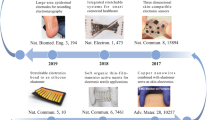Abstract
The use of biofeedback devices has been plagued by the “garbage in—garbage out” problem since its inception. This paper reviews the basics of how to use biofeedback devices for surface electromyographic applications at each stage in the process from sensors to displays so meaningful information can be gathered and utilized.
Similar content being viewed by others
REFERENCES
Andreassi, J. L. (2000). Psychophysiology: Human behavior and physiological response (4th ed.). Mahwah, NJ: Erlbaum.
Basmajian, J. V., & DeLuca, C. (1983). Muscles alive. Baltimore, MD: Williams and Wilkins.
Sherman, R. (2003). Applied psychophysiological techniques for pain assessment and intervention. Wheat Ridge, CO: Association for Applied Psychophysiology and Biofeedback.
Author information
Authors and Affiliations
Rights and permissions
About this article
Cite this article
Sherman, R.A. Instrumentation Methodology for Recording and Feeding-Back Surface Electromyographic (SEMG) Signals. Appl Psychophysiol Biofeedback 28, 107–119 (2003). https://doi.org/10.1023/A:1023806508040
Issue Date:
DOI: https://doi.org/10.1023/A:1023806508040




